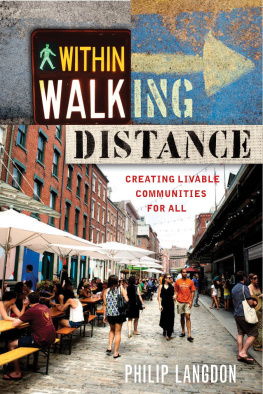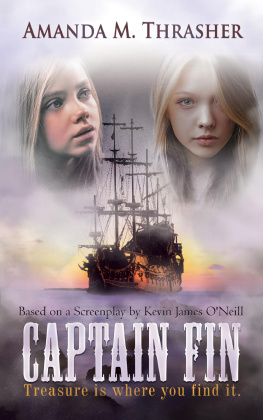All rights reserved under International and Pan-American Copyright Conventions. No part of this book may be reproduced in any form or by any means without permission in writing from the publisher: Island Press, 2000 M Street NW, Suite 650, Washington, DC 20036
Island Press is a trademark of The Center for Resource Economics.
Acknowledgments
Walkable places have long been a passion of mine. In March 1988, I wrote an Atlantic Monthly cover story, A Good Place to Live, about people who were beginning to build new communities in the United States that made walking a central and sociable element of daily life. In the years since, Ive written or edited hundreds of articles about human-scale, mixed-use communities, new and old, for a wide range of publications, including ten enjoyable years with editor-publisher Robert Steuteville at his award-winning newsletter, New Urban News/Better Cities & Towns.
For quite some time, Ive wanted both to distill what I had learned about walkable communities and to dive deeper into a handful of such places, exploring their physical character and their human sides. I am extremely grateful to Richard Oram, who provided crucial financial support for my research and writing through his foundation, the Fund for the Environment and Urban Life.
Heather Boyer, an astute editor at Island Press, brought a much-needed focus and discipline to my sometimes slow and meandering progress. Im elated that Dhiru A. Thadani, a Washington, DC, architect with a gift for illustration, was willing to produce most of the books maps and sketches. When Dhiru was called away by other projects, New Haven architect Ben Northrup stepped in with great skill and created the Little Village map and made last-minute refinements to other maps. Elizabeth Farry, editorial assistant at Island Press, proved invaluable in rounding up and organizing photos.
I am grateful to the many people who showed me their communities, familiarized me with local history and local ways of building, explained the workings of neighborhood organizations and municipal governments, and introduced me to residents. Paul Levy and Linda Harris at Philadelphias Center City District led me to their citys resurgent core neighborhoods and to community groups that have helped those neighborhoods do outstanding things. Thanks especially to Andrew Dalzell and Abby Rambo in Southwest Center City; Janet Finegar and Matt Ruben in Northern Liberties; David Goldfarb, Kandace Gollomp, Dan Pohlig, Dan Rinaldi, Sam Sherman, and Ed and Pam Zenzola in East Passyunk; and Pete Harwan, A. Jordan Rushie, and Isaac F. Slepner in Fishtown. Kevin Gillen, Jennifer Hurley, Alice Ryan, Sandy Sorlien, Murray Spencer, James Wentling, and Inga Saffron, the Philadelphia Inquirers incisive architecture critic, clued me in to aspects of Philadelphia I otherwise might have missed.
In New Haven, Mark Abraham, Will Baker, Ka Wa Chan, Pino Ciccone, Louise deCarrone, Anstress Farwell, Matthew Feiner, Barbara Folsom, Robert Frew, Eva Geertz, Chris George, Seth Godfrey, Bill Kaplan, Joel LaChance, Joe Puleo, Deborah Rossi, Giuseppe and Rosanna Sabino, Lisa Siedlarz, Romeo Simeone, Kevin Sullivan, Melanie Taylor, and Claudia Wielgorecki all expanded my knowledge of East Rock. Also helpful on New Haven were Frank Pannenborg, Patrick Pinnell, and Clay Williams.
Donna Simons and Robert Stevens in Brattleboro, Vermont, and Daniel Scully in Keene, New Hampshire, helped me make contacts in Brattleboro and get an overall sense of the town. In Brattleboro and vicinity, I learned much from Pal Barofsky, Matthew Blau, Pierre Capy, Wes Cutting, Peter Elwell, Alex Gyori, Parker Huber, Dylan Mackinnon, Joelle Montagnino, Orly Munzing, Paul Putnam, Connie Snow, Jeanne Walsh, Allyson Wendt, Bob Woodworth, Greg Worden, and Benjamin Zeman.
In Chicago, Ruth Knack, editor for many years of my articles in Planning Magazine, made me feel at home. Andrea Muoz was a magnificent guide to Little Village, introducing me to Simone Alexander, the Reverend Tom Boharic, Matt DeMateo, Jaime di Paulo, Jesus Garcia, Maria Herrera, Cristel Kolmeder, Ricardo Muoz, Mike Rodriguez, Ciria Ruiz, Kim Wasserman, and others. Scott Bernstein, Matt Cole, Larry Lund, Dominic Pacyga, Carmen Prieto, and Emily Talen also shared their Chicago insights.
In Portland, Oregon, Bruce Allen, David and Anita August, Patricia Gardner, Randy Gragg, Rick Gustafson, Ed McNamara, Michael Mehaffy, Ethan Seltzer, Al Solheim, Bruce Stephenson, and Kate Washington instructed me in many facets of the Pearl District. Thanks also go to Allan Classen, Carolyn Ciolkosz, Joe Cortright, Dick Harmon, Steve Reed Johnson, Rodney OHiser, Steve Rudman, Tiffany Sweitzer, Elise Wagner, and Homer Williams.
In Starkville, Mississippi, Dan Camp and Neil Strickland gave me hours of their time. Mary Lee Beal, Briar Jones, Lynn Spruill, Parker Wiseman, and an observant visiting professor from Notre Dame, Philip Bess, were among the many others who aided my study of the Cotton District.
Peter Chapman, Steve Culpepper, Jennifer Griffin, Richard J. Jackson, Scot Mackinnon, Alan Mallach, Arthur C. Nelson, and Jeff Speck all helped along the way. I thank Kirk Peterson, my friend for fifty years, for riding the overnight train from upstate New York to Chicago to do Spanish-English translation for me in Little Village.
Thanks also go to the many individuals and organizations that allowed me to reproduce their photographs, including Bruce Forster Photography; Friends of Chester Arthur; Steven Koch, Koch Landscape Architecture; Gerding Edlen; Little Village Environmental Justice Organization; Peter Mauss, Esto Photographics, courtesy of Gossens Bachman Architects; Jeremy Murdock, courtesy of The Cotton District; Hannah OConnell, Town of Brattleboro; PhillyHistory.org; Leslie Schwartz; Robert Stevens; and Benjamin Zeman, Mocha Joes Roasting Company.
Most of all, I am grateful to my wife, Maryann Langdon, for seeing me through the many ups and downs of this challenging project.
Introduction
Janet Finegar was talking about the park in her neighborhood, and it was beginning to sound as if the park were a member of her family, maybe a precocious son or perhaps a daughter who was a musical prodigy. My beloved child, Finegar said more than once when describing Liberty Lands, a two-acre park that she, as much as anyone, had created from a wasteland of industrial rubble.
Finegar lives in Northern Liberties, a section of Philadelphia that as recently as the 1990s was bounteously supplied with rubble. Tanneries, cigar factories, breweries, a factory that made records (vinyl ones), and other industries had mostly cleared out of Northern Liberties, leaving the two-third-square-mile corner of Philly for the next generationFinegars generationto come and set it right.










